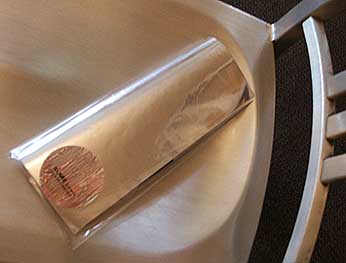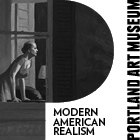
|
||
|
Portland art blog + news + exhibition reviews + galleries + contemporary northwest art
|
||
The Guggernaught, GLARE and Barney vs. Hirst Now that we have recovered from the orgy of art activity in Portland last weekend
we can look elsewhere again:
For example: Jonathan Jones takes a gander at Matthew Barney and decides he is no Damien Hirst in The Guardian. I agree with that. Barney's objects are definitely props and don't hold up as well as the films.... and the films themselves are a bit like Salvador Dali's late work, too full of references as tokens of their own importance to go beyond spectacle. Hirst generates spectacle with objects and doesn't need a projectionist. Hirst is an artist who gets upstaged by his art (purposefully and he sets high bar there), Barney upstages his productions by being himself so when Barney is gone his interesting and admittedly well done films won't have the same charge. Both are artists of spectacle so it's an interesting comparison (Barney is about nuseum extravaganzas and films, Hirst is about making art that survives his own inevitable death and famously avoids big museum extravaganzas). Jerry Saltz takes on the Guggenheim's need to get beyond Krens' Guggernaught of museum building and enviable puppeteering skills that will ensure high turnover or low quality. Saltz is the most important art critic today because he takes his civic responsibility very seriously and frankly may be the last best thing New York has to offer (sorry Jerry but the fumbling of the World trade Center site definitively called New York's cultural pole position into question). Also, the New York Times recently ran a nice piece on restoring Frank Lloyd Wright's Guggenheim Museum. Im a total Frank Lloyd Wright head and grew up in a house designed by one of his apprentices. I adore that museum but was troubled by their announcement of bathroom renovations (officially marking me as a fanatic I fear). I love those tiny circular bathrooms with the crazy triangular lights, they seem like something designed for a cramped space station not a museum. Hopefully those will remain true to their original design with improved plumbing, though size wise these one person units aren't really capable of handling the now massive crowds. Maybe they will simply be restored and the larger, less aesthetically interesting bathrooms at the base and expansion wing will be updated? Fact is they are rare public bathrooms that are essentially private.  Glare Lastly, Portland has a great new publication, GLARE. It is a cultural publication put together by Jeanine Jablonski, this locally produced effort has an international focus. With its shiny cover, an interview with photographer Alec Soth, a profile of Glasgow by some of its artists, a curatorial conversation between John Weeden & Ana Vejzovic Sharp, photos by Portland's hotshot Daniel Peterson and poolside photospread by Natasha Snellman... it's a strong first issue. You can find it at Rock's Box on 6540 N Interstate and Organism (1231 NW Hoyt 12-6 Sat & Sun) in The Pearl in Portland, other locations TBA. You can E-mail GLARE at: info(AT)glarequarterly.com Website will launch late 2007. Posted by Jeff Jahn on September 20, 2007 at 13:23 | Comments (9) Comments The last paragraph from the Guardian's review of the Matthew Barney show at the Serpentine Gallery is worth quoting at length: "The test of seriousness in art, as the novelist Thomas Pynchon observed, is how it faces up to death. By this criterion, Barney is just not a serious artist. Adolescent retardation is a common quality in American art: think of Hemingway having his adventures, Jackson Pollock drinking and raging. But American art in Pollock's time broke through to majestic abstraction. Perhaps Americans can only really make abstract art. The fictional, mythic, symbolist content of Barney's art looks like the guff abstract expressionists painted before they discovered abstraction; the surrealistic style of his drawings is exactly the kind of second-rate figuration from which Pollock had to liberate himself. Barney lacks the direct realism and emotional bluntness that is British art's strength. On this evidence, not only Damien Hirst, but also Richard Serra can rest easy. Who'd have thought there was so little blood in him?"
Posted by: Arcy From the description of the review, it sounds like alot of the pieces in the Serpentine show were also exhibited at SFMoMA earlier this year. A lot of the pieces were reworkings of props he created for his film Drawing Restraint 9. Matthew Barney work is beyond an easy description, you have to experience it. It never fits into any convenient category Take Hirst's Physical Impossibility of Death in the Mind of Someone Living. I know that someone at MoMA just paid 12 million dollars for it, I do not know how many of you have seen it, but for me, it is great as an idea and not as an experience. I have not seen the new one, but the old one was a wrinkled up shark in a big glass container. Great as an idea, great as a photo, great to write about, but not that great when you are standing in front of it. It is no wonder that all the YBA work was bought by an advertising mogul. The work is all about ideas and slogans. It falls short of direct realism, unless it is the realism of the tabloids or you are swimming in the Pacific Ocean. To each their own and maybe a good title like a good slogan is worth 12 million dollars. Maybe we should ask Wieden Kennedy. Here is my theory: The YBA following in the footsteps of the American Pop artists became very succesful at developing the art of the best experienced by the mind. It is fun, it is clever, good for some laughs, but ultimately like a joke told to many times it becomes boring and no longer relevant. It loses it shock value. This is not a criticism, I think it would be hard to expect anything more from a bunch of artists in their twenties. The best American artists: Pollock, Serra, Judd, Reinhardt, Turrell, Newman, Rothko, Heizer... you get the idea and this is an extremely abreviated list. There is not that much for the mind to the hold on to, so you enter into a sort of stasis when you experience their work. For a lack of better description it is seeing the work with the body rather than the mind. It is a place beyond words an easy slogans. It is not about ideas, logic or any place that thinking can take you. We are left to confront ourselves experiencing the work. A maybe more accurately, the work reflects an experience or feeling, back at us in an unexpected way. Paintings of Pollock are experienced the same way as the paintings of anyone else. Either they work or they don't. I do not think it has anything to do with whether he was drinking or not. That's not excuse but anything is fair in painting. When he was drunk and acting poorly it certainly did not make his paintings any better. What about the behavior of Hirst and Emin anyway? The Americans have not cornered the market on stupid behavior or is it fashionable when the Brits do it? Fans of Andrew Wyeth, John Singer Sargent and Norman Rockwell aside, I do think American are best at making abstract art. I think Barney is running into problems in Britain because his work is about experience and not language. It does not fit into words. You are confronted with these strange objects and you are not sure what to make of it. But you are in Barney's world so you just have to experience the ride and go where ever he takes you. It is non-linear and impossible to grasp if there are 500 people standing in the room with you. I think all that Barney is asking you is to pay attention. Posted by: Arcy Arcy, A nice and thoughtful comment and review. I've always felt that Barney was sort of the Steve-O of the artworld. And as for the Art-as-idea-as-art point you're making, I think you're right on. A lot of what some consider as art is little more than one-liners as stagecraft. The novelty wears off quickly, like a display at a trade show. I think that's why artists like Serra, or a few of the Pisarros at PAM can hold one's attention longer. It involves the viewer...rather than just "presenting". And I've always thought Hirst was just a depressed Jeff Koons. Again, well crafted, but Disney none the less. Just two versions of the Macys Thanksgiving day parade. Thanks for allowing me to comment. Take care. Posted by: Sean Casey I thought it was interesting how the British press were suddenly defending Hirst (whom the normally bash). BTW Hirst's work does work as experience too. So it's not just the visceral vs. linguistic at work here. Possibly the British have less taste for the Busby Berkeley follies element in Barney and are cheering on their man in this case. Still, all said and done I'll take Hirst. I simply prefer his directness. Same for Serra. For me Barney is hit or miss, Serra and Hirst hit an awful lot of the time and they genuinely upset people by doing so which can blind some to their work. I think Serra only recently aged to the appropiate point where people will forgive him for doing things his own way. Maybe Hirst will get that eventually too. But Barney, I think he made a ploy at being popular with the cremaster films and is kinda trapped by that success as wierd entertainment. Not a bad problem to have but I like the Serra, Hirst, Picasso way of being difficult for the media and the masses for a long time... only to blend into acceptance during a strong run of late period work. Hirst hasnt hit his late period yet though.
Posted by: Double J It is strange that Jonathan Jones thinks direct realism and emotional bluntness would be a strength to any art, let alone British Art. Barnett Newman said it best: "To put it philiosophically, the European is concerned with the transcendence of objects while the American is concerned with the reality of the transcendental experience." In 1947, Newman was referring to Picasso and Miro. It is strange that Jones is rehashing a line of thought that was debated sixty years ago. British artists have been using things that surround us in the everyday world and put it into a new context by calling art and putting it in a gallery. Fine, so did the cubists and the surrealists. Ultimately, what was initially a strength, it's boldness and it's refreshness is precisely what made it so dated ten years later. I could write a description of The Phsical Impossibility of Death in the Mind of Someone Living in a few paragraphs about the physcial parameters of the piece that would give a reader a fair idea of what it might be like to see the work in person. On the other hand, if I were to write a ten page description on a Mark Rothko painting, I could still never even come close to the experience of standing in front of his paintings. The experience is beyond words and it reveals the limits of language. So in our time maybe we have to overcome the dead sharks, cows and butterflies of Hirst's work to find out that there is more to art than just taking objects of the real world and putting it in a new container. Posted by: Arcy I'm a fan of both strategies and I think Hirst mocks the bluntness of his objects by inviting the philosophical baggage that they entail. One can cherry pick artists from either continent to prove points of who is definable by language or not though... Anish Kapoor and Olafur Eliasson are pretty difficult to simply describe and are best to experience and they are Europeans. Admittedly Kapoor is Indian and an Iraqi as well... he's so complicated. I think Hirst's objects are still current. Right now the only art strategy that looks truly dated are doodley adolescent drawings on paper. The amatuer look is also getting old... it only flies now when something transcendent or life and death is involved. Right now death is one of the top themes in contemporary art (when Hirst started the trend it wasn't so prominent). So I propose that Hirst is the Dean of Death. Barney is something else... the Dean of Referential Obfuscation? The Dean of Tapiaoca? Ok Im not being fair... But I do feel he's the Dean of Induldgence. Yet he's not like Jason Rhoades who somehow could orchestrate the chaos without looking as "cooked" as Barney. I think Barney is important but I think its the permission his work gives to other artists to be obscure... I think Pierre Huyghe has taken Barney's lead and done better more concise work like "A Journey That Wasnt." It's as openended than Barney's work but isnt so saddled with its own production. I dont think Huyghe would have had the same career without Barney. Also I dont think Barney would have had the same career with out Hirst... but I think Hirst and Murakami are the two really protean art forces still active today. In different ways both Hirst and Barney come from Bruce Nauman... only with a lot more showmanship. Frankly Im ready for something new and though I like Tim Hawkinson and Sarah Sze Im looking for someone who is less delightful and more challenging... Arcy perhaps you can whip up the next great thing by next weekened? Barney and Hirst arent going to give us that next new thing. They are the questions of the 90's that we wont be able to escape in the aughts. Posted by: Double J By next weekend? That might be asking a lot and it is already Friday afternoon :) I will say that everything in art, as in life, travels in cycles. The ideas that the YBA's were working with in the early nineties did not just arrive out of thin air but were based on earlier art movements. That said, everything runs its course and I am also desperate for something new. Perhaps the stars of the YBA's are already on the wane. I think that Barney's work is very interesting and that show that I saw at SFMoMA could not be placed into any easy category whether it was painting, sculpture, film, film set, or some unexpected combination of things. It was unlike anything I had ever seen before. But I also agree with you, with one Matthew Barney and we can learn alot, twenty Matthew Barney's and everything risks being lost in obscurity. That is definite danger. So maybe Barney's work is not the next big thing, I am sure that he would prefer that way anyway. But still there must be another way... I was thinking about what you or somebody else was saying about second acts. In Hirst's case it might be difficult because he is so powerful now that he will not go away long enough to be "rediscovered." I do think that the 100 million dollar skull is a lapse in judgement. It is like the double album from a rock band; it is the begining of the end of relevance. Again it works as an idea but not as art. I would love to hear from someone who thinks that the jewelled skull is fantastic and can explain it to me. You have to go away before you can come back. It is interesting that most of the abstract expressionist did not starting exhibting, Pollock is the exception, until their mid-forties and some even later than that. Both De Kooning and Newman I think were like 42 and 45 respectively as an example. By the early sixties they were eclipsed by the pop artists and then most were dead by 1970. There wasn't a second act, except for De Kooning's great paintings of the mid seventies. The whole movement was truncated. By the early eighties Schnabel and Basquiat became known as neo-expressionist but there work was coming out of a different place than some like Pollock, Newman, or Rothko. The minimalists of the sixties and the land art movement of the seventies were closer but still not quite the same. Since everything that is old becomes new again, someone, sooner or later will make these ideas relevant again. I am surprised that no one has picked up on Heizer's work in the desert. Maybe the difference is that most people are concerned with making art that they feel will sell in galleries? Posted by: Arcy Interesting comments and discussion. And oddly familiar. It seems to center around two major points. "New versus derivative", and maybe the "death-of -painting". Things many artists wrestle with. Without having to. The battles were fought (and won) long ago. Children of a lesser Duchamp. Chess anyone? Part of it is generational. Every time and age puts forth a zeitgeist that they can call their own. A student of art today has the luxury of ideas and techniques from all the ages to choose from, without having to explain much. Akin to when a lawyer cites a previous court decision. Many forget that artists held up today as masters suffered many slings and arrows in pushing the boundaries. The rage, anger and disdain not just by critics, but by the public at large. Really the only compariable reaction I see today are directed at a few cartoonists in Europe. The broadest definition of art has naturally opened the doors to those, while not having draughts-person skills, are in the art-making field none-the-less. DeKooning and Warhol both had classic drawing abilities. Mastery of the basics allowed them to be turned in on itself. The death of painting is that other tired saw, only to return (like 2pac) to rear it's all-pervasive head just as the obituary is written. Which brings up the earlier mentioned Heizer...an excellent choice. Precedents are pretty scant when it comes to what he and others did in shifting not just the art, but the venue it's in. "Art-itecture" in a sense. Could anyone say, after visiting Double Negative, that it looked better in the magazine? History, in it's long slow frustrating way, decides. The discussion is interesting none the less. Thanks for allowing me to comment. Posted by: Sean Casey Hi Sean and everybody, Thank you for the nice post. I would like to offer a variation on the "new vs. derivative" discussion. I have been reading the collected writings of Ad Reinhardt this week and I was surprised by two things. First, he was making the black paintings for twelve years and second he thought that the"+":shaped format was so generic, he hoped that other artists would use the format as well. Even, more interesting was that he wanted others to use the same format not because he was competitive but because since the formats would be similar, they would be easier to look past, and we can get closer to the "art". A couple of weeks ago I learned about Reinhardt's response to "There is no such thing as good painting about nothing." Reinhardt rejoiner was "Yeah, and there is no such thing as good a painting about something either." In a way they are both right, Rothko was talking to people that did not understand his paintings and Reinhardt I think was talking to other artists. I think I am being to get a little suspicous of the next "new" thing. Consider Agnes Martin's work, she did not invent the horizontal line or the grid but she did something extraordinary. Newman did not invent the vertical line on a rectangular canvas. I think that in both cases their work was outside, or beyond, invention. Perhaps this because Martin's work is more than the horizontal line and Newman's more than the vertical line. They are the means and not the ends. Or maybe the real thing about art is that it does not have anything to do with being new or inventive at all. In Heizer's case, I would say that he was also unoriginal. He did not invent the mesa or the idea of digging a hole, but the effect of Double Negative is still extraordinary. So often invention, has to do formal invention which get so boring so quickly. This brings us back to interesting point about Hirst. I will stick to my guns a little bit here and say that I think his work is still about ideas and not experience. I was talking about the shark earlier, but the dot paintings are about a conceptual grid of circles that can be filled in with non-repeating colors. It is fine, as an idea. In his fishing tank vitrines, or the one with the skeletons, or that statues he is always trying to push the boundaries. He is always trying to shock you and he is always trying to out do himself. I can't help but think of him running around and saying art is here, and here, and here....etc. The funny thing is that he is right but he never slows down long enough to experience it. The proof is that he felt that he had to continue to out do himself until he finally reached the end by covering a skull with jewels that costs 100 million dollars. What does that have to do with art? How can that be based on anything other than a progression of ideas as the basis for his art rather than the experience of art? I would like to say by contrast that when Martin was making paintings with horizontal lines for 35 years she was not repeating herself, she was still only getting closer to the art. Rothko can make 400 variations on the same typology of a paintings and we wish he made even more. What they were looking for in art is fundamentally different than what Hirst is looking for? Hirst was looking to be rich and famous and he got it. Maybe that is where the art is for him. I think that Rothko wanted to be rich and famous but it did not happen for a long time and perhaps it was frustratingly isolating when it did. Martin I do not think was that interested in becoming rich or famous and that is why she lived by herself in New Mexico. I think that hits upon why the best American art is fundamentally different than what had came before. But the strength is in the quality of the work rather than in being different. Sorry, I feel like I have been picking on Hirst a little too much here. Next time, I will use different example. Let me try to make this point a little more succintly. An idea artist produces art to elicit a specific reaction in the viewer whether it is intellectual or emotional. An experiential artist uses fewer parameters to free the viewer to have their own experience, which is based on but still separate than the work. Another way to see is that the idea artist believes that the art is in the artist and the work. The experiential artist believes that the work set ups the parameters of the experience but the art ultimately resides in the viewer. This why it is not necessary for the experiential artist to be "inventive" because the art is not there in the first place. Posted by: Arcy Post a comment Thanks for signing in, . Now you can comment. (sign out)
(If you haven't left a comment here before, you may need to be approved by
the site owner before your comment will appear. Until then, it won't appear
on the entry. Thanks for waiting.)
|
| s p o n s o r s |
 |
 |
 |
 |
 |
 |
 |
 |
 |
 |
 |
 |
 |
 |

|
Site Design: Jennifer Armbrust | • | Site Development: Philippe Blanc & Katherine Bovee | |


![[TypeKey Profile Page]](http://www.portlandart.net/nav-commenters.gif)